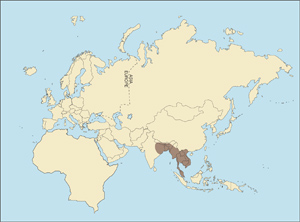 |
 |
Bubalus bubalis
Búfalo acuático, Búfalo Asiático de agua (Sp), Wasserbüffel, Sumpfbüffel (G), Buffle d'eau, Buffle de l'Inde (F). Also called Asian water buffalo or Indian buffalo. Scientific name is from the Greek boubalos (buffalo). Some authorities distinguish between the domestic (including feral) water buffalo as Bubalus bubalis and the wild Asian water buffalo as B. arnee, while others, including ourselves, do not. As it was the domestic form that was first described for science, the name bubalis Linnaeus, 1758 takes precedence.
DESCRIPTION Head and body length 8-10 feet (2.4 to 3.0 m). Tail length 24-39 inches (60-100 cm). Shoulder height 59-75 inches (150-190 cm). Weight 1,550-2,650 pounds (700-1,200 kg).
A large, heavily built animal with stout legs and large, splayed hoofs. The skull is relatively light, long and narrow, and has a nearly straight profile. Muzzle is large and hairless. Ears are relatively small and not heavily haired. Tail reaches to the hocks and ends in a small tuft. General color is black or gray, with the lower legs a dirty white, and there often is a narrow white "V" on the throat. The coarse, sparse coat is moderately long and directed forward from hindquarters to head. The horns (both sexes) are heavy at the base, triangular in section, flat on top with conspicuous wrinkles, and grow out from the sides of the head without forming a boss. At one time two distinct types of horn curvature were recognized in wild water buffalos, and were given subspecific rank. In one, which was considered the typical race (bubalis), the horns formed a regular curve in the shape of a semicircle. In the other (macroceros) they were characterized by their great length, growing directly outward and turning up only near the tips. The long-horned buffaloes were found in Assam and Cooch-Behar; however, they have apparently been extinct as wild animals for many years, and macroceros is no longer considered a valid subspecies in any case. The horns of females are rounder in cross-section and lighter than those of males, but may be considerably longer. The longest horn of record (Rowland Ward, 1913) is 70-1/2 inches (179.1 cm), the largest circumference (1909) 23 inches (58.4 cm), the greatest outside spread (1933) 93-1/2 inches (237.5 cm).
BEHAVIOR A gregarious animal, with females and their young forming stable herds led by an old cow, and males in separate bachelor groups. Very old bulls are usually solitary. Males move into cow areas during the breeding season; dominant males mate with but do not control the females, and are subsequently driven off. Normally, one calf is born after a 10 to11-month gestation period, and it nurses for 6-9 months. Life span in the wild as much as 25 years.
Mainly diurnal, feeding early and late, resting at midday. Diet is mainly grasses. Water is a requirement both for drinking and bathing. Counters biting insects by submerging with only the nostrils exposed, or by covering itself with a layer of mud. Sense of smell is keen, eyesight and hearing fairly good. Males have been known to attack humans without apparent provocation; females also can be dangerous, especially when with their young. Water buffaloes have been known to kill tigers, and are used in driving wounded tigers from heavy cover.
HABITAT Flat terrain with tall grass, reedbeds, swamps, water courses and mud wallows.
DISTRIBUTION & STATUS The wild water buffalo was formerly widespread from eastern parts of Nepal and India eastward throughout Indochina, including the Malayan Peninsula. It has become extinct over much of its original range from loss of habitat to agriculture and domestic cattle diseases, but a few herds, which are believed to be descended from native stock, are still found in reserves or remote areas of Nepal, northeastern India, and Indochina. The wild water buffalo is listed as endangered by the IUCN and on Appendix III of CITES (as Bubalis arnee).
On the other hand, at least 130 million domesticated water buffaloes are now found worldwide in warmer areas-mainly India, Indochina and the East Indies-both as domestic and feral animals. Domestication begun about 5,000 years ago in the Indus valley, 4,000 years ago in China, and had spread throughout the Middle East by A.D. 600. There is no biological difference between the wild and domestic varieties, as the genus does not hybridize with domestic cattle; however, considerable differences exist in horn size and shape, because domestic buffaloes are often deliberately bred for small horns, with a variety of short, curled and even deformed horns resulting. Conversely, feral buffaloes may grow horns that are as large or larger than those of wild specimens. Although some domestic water buffaloes may be black and white, brown and white, or even mostly white, free-ranging feral buffaloes are identical to their wild relatives and it is often impossible to tell which is which. The free-ranging feral water buffalo is not endangered and may be hunted in many places. It is a fine game animal and its horns are a spectacular trophy.
|





